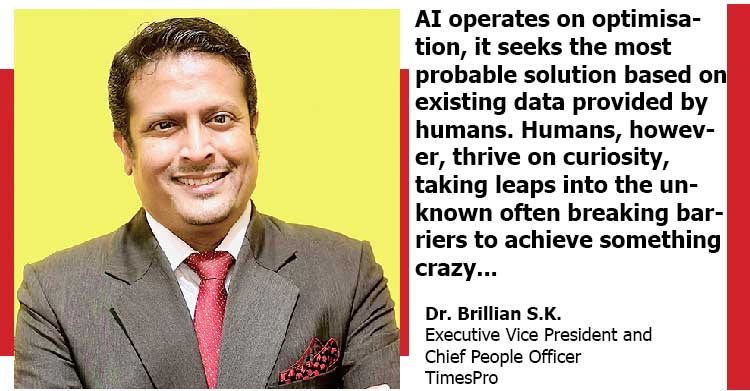Can a humans beat AI? | Dr. Brillian S.K. | Executive Vice President and Chief People Officer | TimesPro

“Kya hum ab bhi relevant hai?” many are wondering.
Let’s be real, in this age where AI writes poetry and robots make food. The undisputed answer is “humse behtar koi nahi”.
Remember when Kabir Khan said in Chak De India – “Sattar minute hai tumhare paas… wo bhi khatam hone waale hai!” That’s human intelligence.
AI on the other hand needs perfect data. We? We work miracles with half-baked information, zero sleep and unlimited chai (or coffee of whatever is your poison).
In the grand (almost intergalactic) war between technological prowess and human connection, we consistently find that while technology may dazzle with its efficiency and scale, it is ultimately the human touch that prevails. The most advanced AI systems can process information at unimaginable speeds, yet they cannot replicate the warmth of a comforting hand, the intuition of an experienced mentor, or the creative spark that emerges purely from human collaboration.
AI operates on optimisation, it seeks the most probable solution based on existing data provided by humans. Humans, however, thrive on curiosity, taking leaps into the unknown often breaking barriers to achieve something crazy. It is not surprising that many of the greatest breakthroughs came from accidents and intuition. Penicillin, the microwave, and even the Post-it notes were discovered through unplanned experimentation.
Despite what the pseudo experts say about AI replacing humans, the one thing that is irreplaceable is the Human. If we look at the healthcare domain, AI aids in drug discovery and data analysis, the hypotheses still come from humans. AI has taken great strides in achieving significant scale, it can diagnose with remarkable accuracy, but it is the nursing assistant’s reassuring presence, the doctor’s empathetic delivery of difficult news, and the mother’s gentle assurance that truly helps in healing.
Let us shift our focus to the most impacted domain, education, adaptive learning software personalises content, but it is still the teacher who inspires, motivates, and recognises the unspoken needs of learners. These are not simple, or documented and considering the complexity of human emotions AI may end up getting confused or creating chaos.
AI could be used by organisations for sentiment analysis, algorithms can help detect various emotions including anger, joy, or sarcasm in tone, and chatbots simulate empathy. Yet, AI has no subjective experience, no grief, love, or passion. A counsellor does not just follow a script; they perceive micro-expressions, tone shifts, and unspoken pain. A leader doesn’t just process data; they inspire teams through trust and shared purpose.
If you have ever used a Radio cab without a human based customer service, you will agree with me; AI chatbots can handle routine queries efficiently, but frustrated customers often NEED a human agent. It is always the humans on the other side that provides a genuine reassurance, adapting responses in real-time with emotional nuance. AI can simulate care, but it will never match the human capability to connect.
AI thrives in structured environments with clearly defined rules, fraud detection, or assembly line processing. But real life it is messy and unpredictable. Humans navigate ambiguity, improvise solutions, and learn from minimal information. A doctor in the emergency room doesn’t have time to consult a database; they rely on gut, instinct and experience.
Children learn languages effortlessly, adapting to slang, accents, and nonverbal cues. AI language models require massive datasets and still struggle with understanding sarcasm or the cultural context.
Humans generalise knowledge, a chef can apply techniques from French cuisine to invent a new dish, while AI merely replicates from what was made available to them. The classic example of “Indian Chinese Food” a China man would probably sulk and run away. We adapted the food to suit our palate and style. AI can never do that.
Who can forget the Dabbawalas, their system for human efficiency, no AI can replicate, or Guptaji the neighbouring Kirana shop owner whose memory stores and recalls faster than what modern CRM systems can.
Rather than diminishing the human touch, I believe, technology at its best amplifies our ability to connect. CoVid-19 is a testimony to how it helped us transcend barriers and overcome challenges despite trying times. The now frequent, video calls bridged distances between loved ones giving the comfort of being able to put name to face and experience emotional connects.
The reach of social media platforms enabling global reach without the need for physical travel. I have delivered sessions in Australia, Singapore, Bahrain, US without moving even an inch all streamed from my study. All of these are proof that AI and technology are enablers.
AI tools have freed up time for more meaningful interactions with fellow humans. Technology serves as conduit for human connection, not replacements for it. The magic happens in the spaces between the technology – in the laughter shared during a glitchy video call, the handwritten note accompanying an online order, or the human judgment applied to AI-generated recommendations.
AI, Machine learning models inherit biases from their training data. Facial recognition, hiring algorithms thrive on the bias of the inputter, and chatbots occasionally mess up. Why? Because AI learns from us, including our flaws.
Humans can recognise and correct bias, AI perpetuates biases unconsciously. However humans question, debate, and reform systems. AI has become so integrated with what we do that we have teams working on ethical AI research, which are all human driven aimed at correcting systemic flaws. It may be appropriate to say AI lacks fairness, it only reflects what it’s fed aligned to the adage of “as thou sow, so shall thou reap”.
AI is a great testament to human curiosity. Generative AI doesn’t “think”, it predicts and provides responses based on patterns. DeepBlue never understood chess, it calculated probabilities. The intelligence behind AI is, and always will be, human. So when Gary Kasparov defeated DeepBlue, he was in fact playing against a human who was invisible.
The narrative of “humans vs. AI” is completely misleading. We need to treat AI as a tool, not a rival. The real potential lies in synergy. AI can handle volumes be it data crunching, automation, etc. Humans can handle vision, strategy, creativity, ethics.
Together, we can achieve what neither could alone. No algorithm can replicate the power of a mentor seeing potential no test could measure, or a leader inspiring through authentic vulnerability. An artist moving audiences in ways data can’t explain or a simple human presence saying “Its OK, I understand” without words.
In this evolving landscape, we must remember that every technological advancement is ultimately judged by how well it serves human needs and nurtures human relationships. As we evolve, the most impactful innovations will be those that go beyond the cliched Tech v/s Touch mindset. It would be about acknowledging the primacy of human connections as core to all decisions and actions, removing barriers to help build meaningful interactions and enhancing human judgment and creativity. The companies, products, and systems that thrive will be those that recognise this fundamental truth that in the battle between tech and touch, it’s always touch that wins in the end.
AI is like Chak De’s hockey, a powerful tool. But the players? Always human. This is our advantage, the irreplaceable value of human connection that no technology can duplicate, only facilitate. As we build the future, let us design with this truth at the centre.


